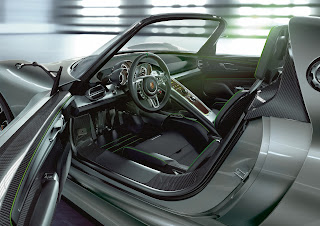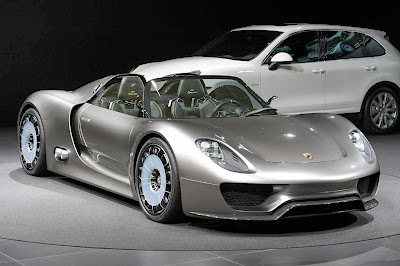Porsche 918

This race-bred powerplant descended from the championship-winning Porsche 918 Spyder’s racing V-8. The Porsche 918 salient features that take it to the outer limits of power per cubic inch include centrally located direct fuel injectors.Porsche 918 variable intake- and exhaust-valve timing, finger-follower valve actuation with Porsche 918 hydraulic lash control, forged
titanium connecting rods, dry-sump lubrication, and a flat (180 degree) forged-steel crankshaft. Porsche 918 crank’s flat configuration enhances cylinder filling while adding wickedness to the exhaust note. There are no belt-driven accessories in the Porsche 918. Porsche 918 clutch between the V-8 and the centrally located 154-hp electric motor provides stop-start operation to eliminate fuel consumption in some operating modes.Porsche 918 is the first-ever naturally aspirated engine with exhaust ports located in the valley (hot-V configuration). Porsche 918 turbocharging, a longstanding Porsche strength, was not employed here because two electric propulsion motors provide ample torque at the low end of the rev range, freeing the engine tuners to strive for spectacular high-rpm power.
Porsche 918

There are three clutches and seven forward gears but not a clutch pedal or an H-pattern in sight. Porsche 918 With two masters to serve—speed and fuel efficiency—technology has moved past the conventional manual transmission Porsche 918 used so satisfyingly in the 2004 Carrera GT. Versus the previous supercar’s,Porsche 918 today’s dual-clutch seven-speed provides a 37-percent-greater ratio spread, no interruption of power delivery during upshifts, and faultless operation that doesn’t depend on a skilled driver. In simple terms, the Porsche 918 dual-clutch way is quicker and significantly more fuel efficient. The driver gets shift paddles to play with and a dash toggle (park, neutral, drive, reverse) that looks suspiciously like a Toyota Prius’s shifter.
Porsche 918
The porsche 918 shares three gear ratios and the basic layout of the 911 Carrera’s PDK transaxle. Porsche 918 suit this mid-engine layout and to lower the height of the engine and its electric-motor teammate.In Porsche 918 the gearbox is rotated 180 degrees about two axes—vertical and horizontal—versus the 911’s orientation. As a result, the center of gravity is approximately 14 inches, five inches lower than in the current 911 Carrera. Porsche 918 Inconel Pipes Meet Ceramic Balls Minimizing weight through the use of exotic materials is the best means of maximizing performance and fuel efficiency without compromise. Toward that end, the Porsche 918’s structural core is a resin-injection-molded passenger tub bolted to a composite space frame that surrounds and supports the engine, transaxle, and rear suspension. Making Porsche 918 supplementing the mostly carbon-fiber structure and body panels, the brake rotors are carbon ceramic, the optional wheels are forged magnesium, the exhaust system is Inconel (a nickel-based alloy containing chromium, iron, and other elements), and the Porsche 918 fuel tank is super-formed aluminum. The Porsche 918 engineering team chased every gram, resorting to ceramic balls to trim 18 ounces from the optional Weissach package’s wheel bearings.
courtesy by http://www.caranddriver.com










No comments:
Post a Comment